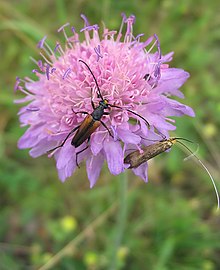This article has multiple issues. Please help improve it or discuss these issues on the talk page. (Learn how and when to remove these messages)
|
| Knautia arvensis | |
|---|---|

| |
| Scientific classification | |
| Kingdom: | Plantae |
| Clade: | Tracheophytes |
| Clade: | Angiosperms |
| Clade: | Eudicots |
| Clade: | Asterids |
| Order: | Dipsacales |
| Family: | Caprifoliaceae |
| Genus: | Knautia |
| Species: | K. arvensis |
| Binomial name | |
| Knautia arvensis (L.) Coult. | |
Knautia arvensis, commonly known as field scabious, is a herbaceous perennial species of flowering plant in the honeysuckle family Caprifoliaceae.
Description

It is a perennial plant that grows between 25 and 100 cm (9.8 and 39.4 in). It prefers grassy places and dry soils, avoiding heavy soils, and flowers between July and September. The flowers are borne on inflorescences in the form of heads; each head contains many small florets. The head is flatter than in similar species, such as devil's bit scabious (Succisa pratensis) and small scabious (Scabiosa columbaria). There are 4 stamens in each floret, and 1 notched long stigma. The fruit is nut like, cylindrical and hairy, 5–6 mm (0.20–0.24 in) in size. It has a tap root. The stem has long stiff hairs angled downwards. The leaves form a basal rosette, are paired on the stem, the lowest typically 300 mm (12 in) long, spear shaped, whereas the upper are smaller. There are no stipules.
Ecology
It is occasionally used by the marsh fritillary as a foodplant instead of its usual foodplant of devils bit scabious (Succisa pratensis). It is also the foodplant of the narrow-bordered bee hawk-moth (Hemaris tityus).
Name
Species of scabious were used to treat scabies, and many other afflictions of the skin including sores caused by the bubonic plague. The word scabies comes from the Latin word scabere 'scratch'. Another name for this plant is gipsy rose. The genus Knautia is named after a 17th-century German botanist, Christian Knaut.
Habitat
Commonly found on roadsides and field margins, and in meadows, it is particularly abundant where there is chalk bedrock.
Gallery
-

-
 with Aphantopus hyperantus
with Aphantopus hyperantus
-

-

-
 leaves
leaves
-
 Young fruit
Young fruit
-
 basal leaf - note that in this species it is lobed, whereas Devils Bit scabious it is not
basal leaf - note that in this species it is lobed, whereas Devils Bit scabious it is not
-
 In Belarus
In Belarus
-
 Field scabious phenology
Field scabious phenology
References
- Kingfisher Field Guides: Wild Flowers of Britain and Northern Europe
- The I-Spy Guide to Wild Flowers by Michelin
- British Geological Survey - Karst Aquifers
- BSBI distribution maps
- Nature Spot - Field Scabious
| Taxon identifiers | |
|---|---|
| Knautia arvensis |
|
This Dipsacales article is a stub. You can help Misplaced Pages by expanding it. |